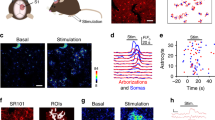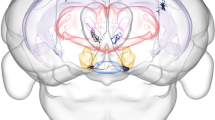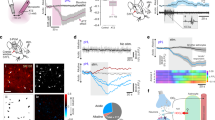Abstract
IN a recent communication1, Hertz has postulated an impulse transmission system in which “potassium ions, which have been lost from one nerve cell during its activity, are transported through neuroglia cells to the outer surface of another nerve cell, which is then depolarized and stimulated; that is, a neuronal–neuroglial–neuronal impulse system”. For such a system to operate, the neuroglia cells should bear an appropriate topographical relationship to the nerve cells and should have a capacity for active ion transport; for the pathways to be selective there should be no significant diffusion of potassium ions between cells. Hertz has given good supporting evidence for the second premise, the capacity of glia cells for active ion transport; but the first and third require examination.
This is a preview of subscription content, access via your institution
Access options
Subscribe to this journal
Receive 51 print issues and online access
$199.00 per year
only $3.90 per issue
Buy this article
- Purchase on Springer Link
- Instant access to full article PDF
Prices may be subject to local taxes which are calculated during checkout
Similar content being viewed by others
References
Hertz, L., Nature, 206, 1091 (1965).
Scheibel, M. E., and Scheibel, A. B., in Biology of Neuroglia, edit. by Windle, W. F., 5 (Charles C. Thomas, Springfield, I11., 1958).
Peters, A., J. Anat. (Lond.), 96, 237 (1962).
Peters, A., and Palay, S. L., J. Anat. (Lond.), 99, 419 (1965).
Gray, E. G., in Electron Microscopy in Anatomy, edit. by Boyd, J. D., Johnson, F. R., and Lever, J. D., 54 (Edward Arnold, London, 1961).
Herndon, R. M., J. Cell Biol., 18, 167 (1963).
Cummins, J., and Hydén, H., Biochim. Biophys. Acta, 60, 271 (1962).
Eccles, J. C., The Physiology of Synapses (Academic Press, New York, 1964).
Frankenhaeuser, B., and Hodgkin, A. L., J. Physiol., 131, 141 (1956).
Horstmann, E., and Meves, H., Z. Zellforsch. mikroskop. Anat., 49, 569 (1959).
Coggeshall, R. E., and Fawcett, D. W., J. Neurophysiol., 27, 229 (1964).
Nicholls, J. G., and Kuffler, S. W., J. Neurophysiol., 27, 645 (1964).
Cited by Pappenheimer, J. R., Physiol. Rev., 33, 387 (1953).
Ochs, S., in International Review of Neurobiology edit. by Pfeiffer, C. C., and Smythies, J. R., 4, 1 (Academic Press, New York, 1962).
Van Harreveld, A., and Schadé, J. P., J. Cell. Comp. Physiol., 54, 65 (1959).
Hydén, H., and Egyházi, E., Proc. U.S. Nat. Acad. Sci., 48, 1366 (1962).
Hydén, H., and Egyházi, E., Proc. U.S. Nat. Acad. Sci., 49, 618 (1963).
Barondes, S. H., and Jarvik, M. E., J. Neurochem., 11, 187 (1964).
Author information
Authors and Affiliations
Rights and permissions
About this article
Cite this article
WENDELL-SMITH, C., BLUNT, M. Possible Role of Neuroglia. Nature 208, 600–601 (1965). https://doi.org/10.1038/208600a0
Issue Date:
DOI: https://doi.org/10.1038/208600a0
Comments
By submitting a comment you agree to abide by our Terms and Community Guidelines. If you find something abusive or that does not comply with our terms or guidelines please flag it as inappropriate.



